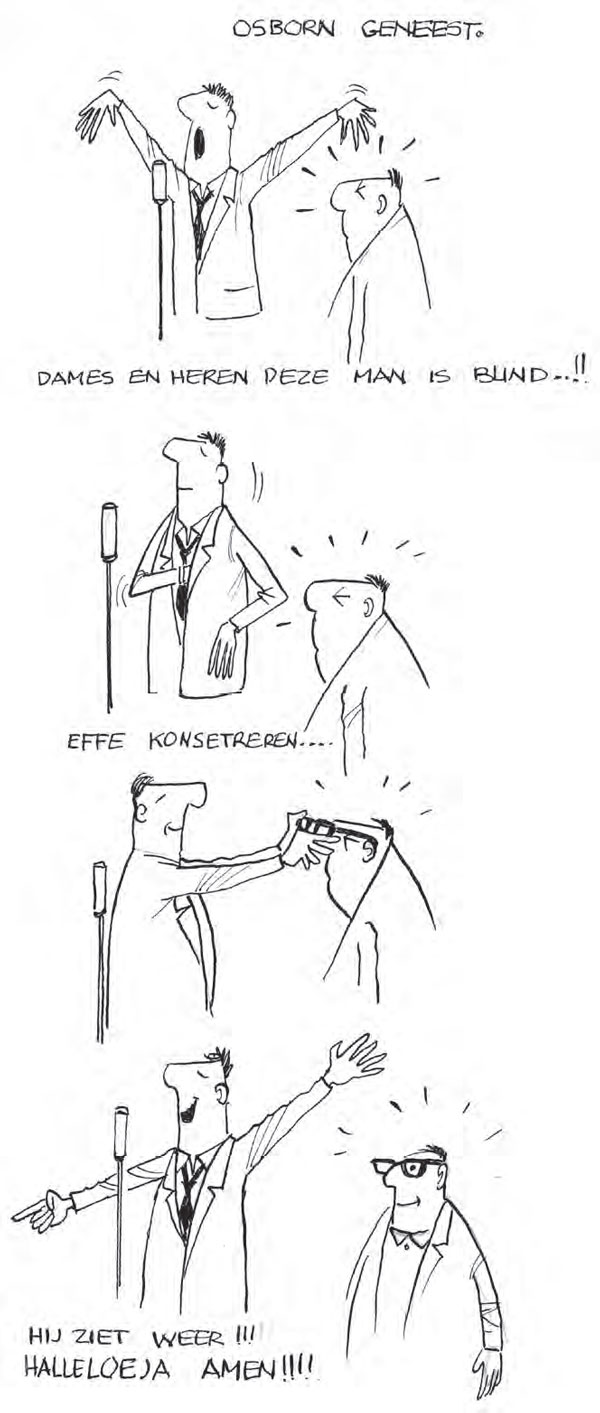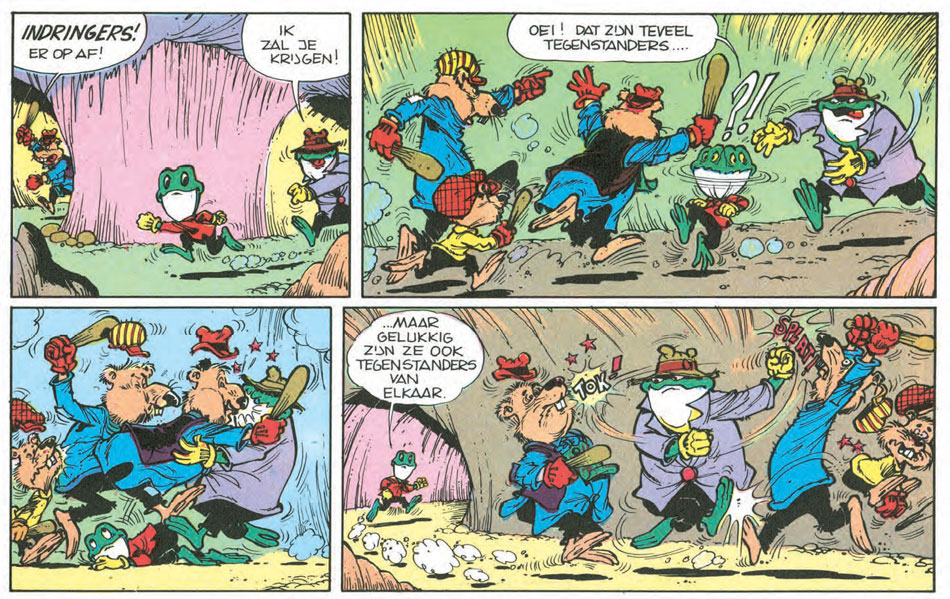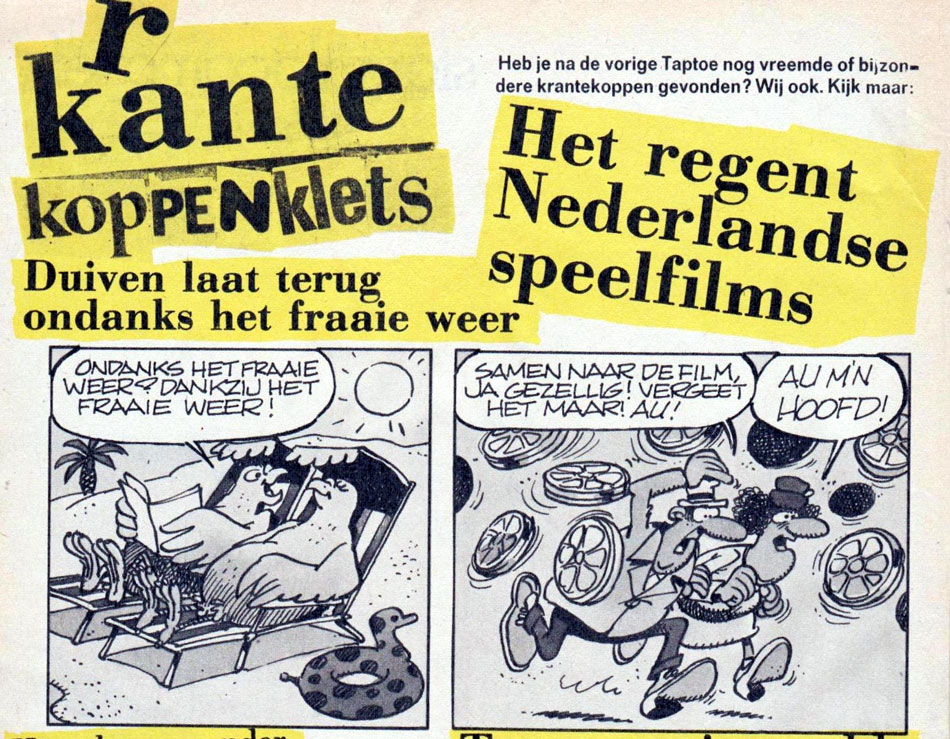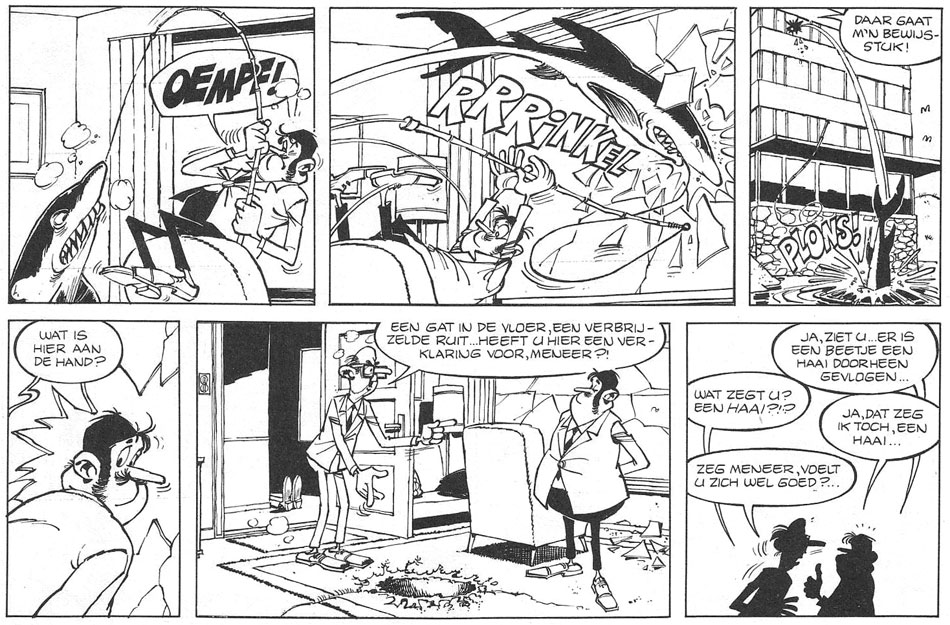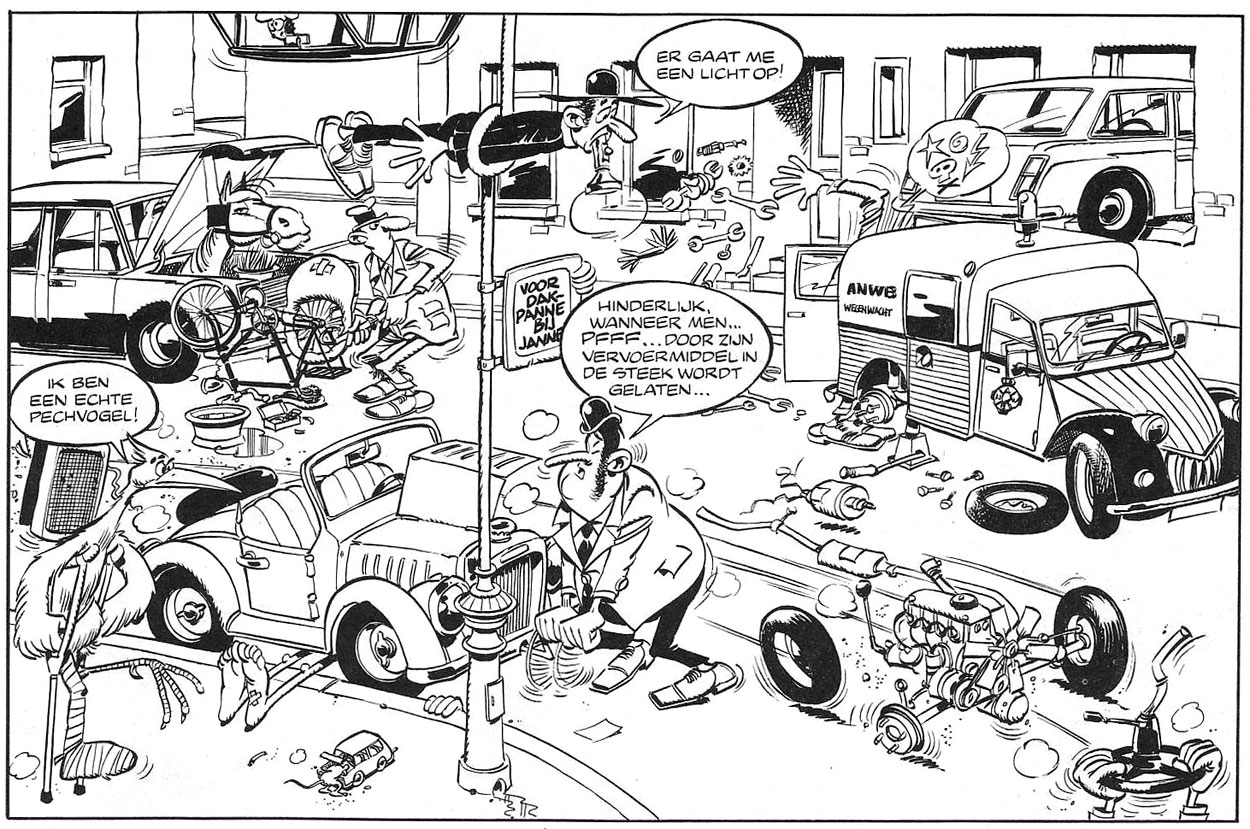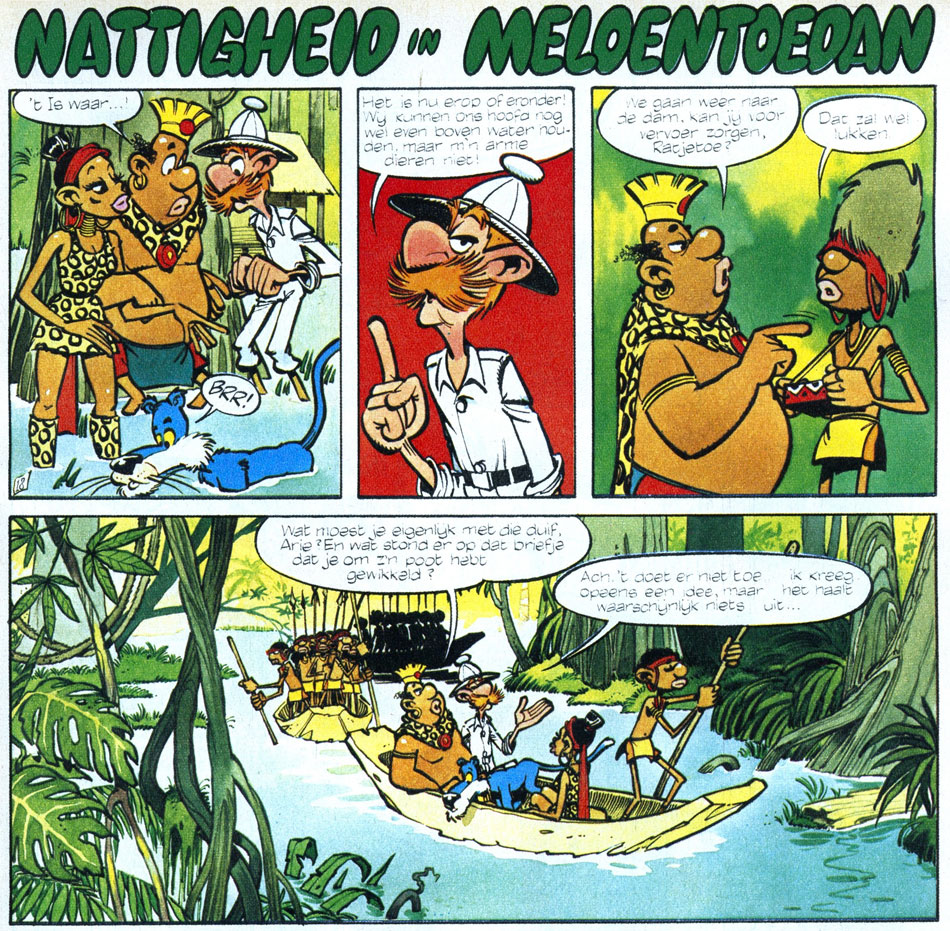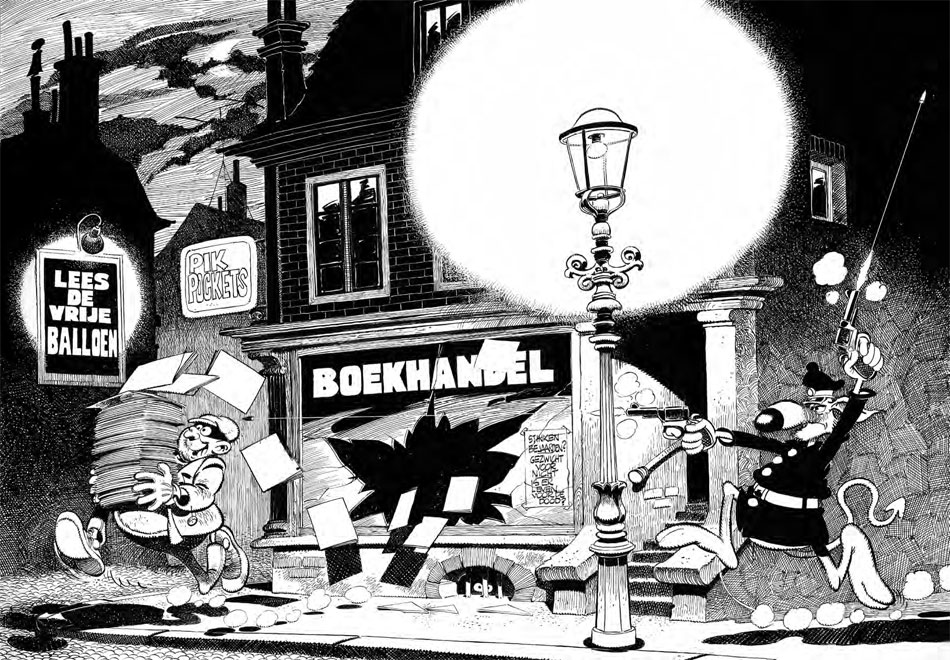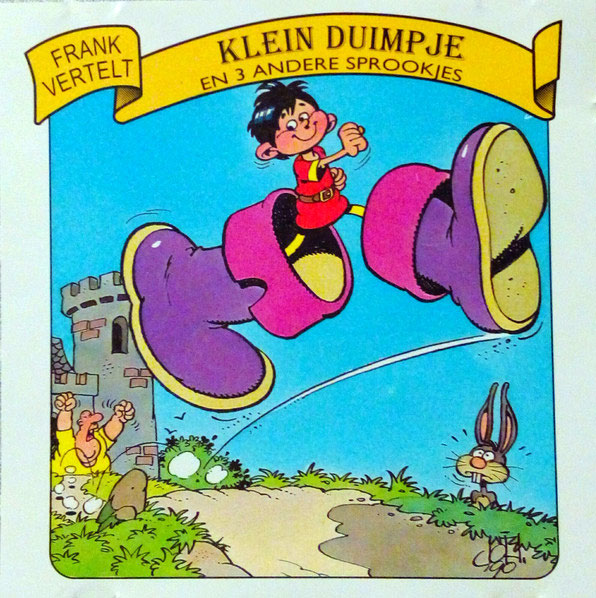'Baron van Tast' (Pep #20, 17 May 1974)
Jan van Haasteren is a Dutch comic artist and illustrator, whose work is characterized by its high density of visual jokes and absurdities. Before becoming highly successful with his large and hilariously crowded jigsaw puzzle drawings for jigsaw puzzle company Jumbo, he had a fruitful career in the Dutch comic industry. Starting in the 1960s, he drew for several productions of the Toonder Studio's, including work on Marten Toonder's 'Kappie' strip and licensed stories with Disney and Hanna-Barbera comics characters. With writer Andries Brandt, Van Haasteren was the original artist of the studio's semi-realistic newspaper comic 'Aafje Anders' (1970-1972), later continued by other artists. Moving on to doing magazine work, notable comic creations by Jan van Haasteren were the gag comic 'Bartje en Opa'/'Erik en Opa' (scripted by Patty Klein, 1967-1980), about a boy and his grandfather, and the escapades of the hallucinating 'Baron van Tast' (1972-1975). In 1975, Van Haasteren was one of the co-founders of the Dutch underground comix magazine De Vrije Balloen, where artists could do their own thing and experiment. He also created the magazine's mascot, Tobias Quintenpreut. During the 1970s and 1980s, Van Haasteren gradually shifted from comics to commercial art. Active well into his 80s, Jan van Haasteren has been joined by artists like Rob Derks, Dick Heins, Mars Gremmen and Wilma van den Bosch to secure a steady production of crowded jigsaw puzzle drawings for Jumbo's Studio Jan van Haasteren division.
Early life and career
Jan van Haasteren was born in 1935 in Schiedam, a harbor town in the province of South Holland. A young boy during World War II, Van Haasteren lived through bombings and the Hunger Winter, but was too young to be fully aware of the severity of the situation. Shortly after the war, he was put on a Red Cross transport of malnourished children to England, where he spent a couple of months with a foster family. It wasn't until two or three years after the liberation before the Van Haasteren family was fully reunited in the Netherlands.
Jan inherited his creative talent from his mother Elizabeth, who made watercolor paintings and showed interest in the comics and illustrations in magazines. His father Albertus van Haasteren was a technical draftsman and engineer, who had among his clients the Observatory and Van Berkel's Patent, a company producing scales. As father Van Haasteren was often busy inventing and developing products in the basement of the house, his sons regularly assisted him. As a child, Jan already created cartoony portraits of his father, drawing him amongst his machines and "inventions". He devoured the comic strips in the newspapers, from 'Mickey Mouse' to 'Popeye', as well magazines like Okido, Tom Poes Weekblad and the digest-sized 'Dick Bos' comic books by Alfred Mazure. Among the early comics he read and copied were Wim Meuldijk's 'Sneeuwvlok de Eskimo' and 'Ketelbinkie'. Playing outdoors, Jan and his brother Herman (b. 1937) enjoyed pranking the neighborhood, swimming in the river Maas and setting fire to chunks of carbide, a hobby Jan later revived with his comic character Tinus Trotyl. Later in life, Jan's younger brothers also turned to creative professions, Herman becoming a photographer and Cor (b. 1949) a fine artist. Jan initially desired a career in fine art, but his father was strongly opposed to this, as his uncle Gerrit was an art painter and always flat broke.
Gag cartoon by Jan van Haasteren. Translation: 'Osborn cures'. - 'Ladies and gentlemen: this man is blind. Let's concentrate... he can see again!!! Hallelujah, amen!!!'.
In 1949, Van Haasteren enrolled at Schiedam's trade school, where he spent two years learning to become a house and decoration painter. At home, he decorated the walls of his own room with funny creatures, including one of his later trademarks: a pair of hands sticking out of a built-in wall cupboard. Between 1951 and 1955, Jan van Haasteren attended the Academy of Visual Arts and Technical Sciences in Rotterdam, studying advertising art. One of his fellow students was Wim Giesbers. Although he was a persistent prankster, he graduated with ease. While fulfilling his military service in between, Van Haasteren left the parental home and began his career with the small Rotterdam-based advertising studio Grijseels, before landing a job with the larger agency Nijgh & Van Ditmar.
Working for this company from 1957 to 1961, he first joined the team of the advertising department, and then became a storyboard artist in the film department led by Loek van Delden. In his spare time, he assisted Van Delden on his newspaper comic 'Smidje Verholen'. During his first steps as a comic artist, Van Haasteren did the strip's lay-out sketches, after which Van Delden made the finished pencil art and Frits Kloezeman provided the inking. In 1958, some of his cartoons were included in the 'Mallenmolen' pocket book series of publisher Born. At the time, he was strongly inspired by the absurdist humor of André François and the sports cartoons of Claude Serre. Among his other influences are the artists of Mad Magazine, most notably Jack Davis and Wallace Wood, the U.S. cartoonist Elzie Crisler Segar and the Franco-Belgian comic creators André Franquin and Jean Roba. Later, for his crowded puzzle drawings, important inspirations were Jan Sanders and Jean-Jacques Loup.
'Kappie en het Bollejong' (1965).
Toonder Studios
His managers at Nijgh & Van Ditmar noticed that a prankster like Jan van Haasteren wasn't suited for doing boring lay-out work. Seeing a cartoonist in him, they redirected him to the studio of Marten Toonder in Amsterdam, at the time the largest production house of comics and animation in the Netherlands. On 1 April 1961, his employment began. After spending about one or two years as cleaner and inbetweener at the animation department under Børge Ring, he joined the studio's comic production. Among his early tasks were doing coloring and lettering chores on the weekly 'Tom Poes' balloon comic for Donald Duck weekly. Between 1963 and 1966, Van Haasteren was the main pencil artist of Marten Toonder's newspaper strip about tugboat captain 'Kappie', at first written by Lo Hartog van Banda and Andries Brandt and then by Eiso Toonder. Richard Klokkers provided the inking. Van Haasteren's involvement lasted from story #98 ('Kappie en de Magnetische Scheepvaart') through #112 ('Kappie en het Misteiland'), after which Terry Willers took over pencil duties.
'Hiawatha' story for the Dutch-language Disney weekly Donald Duck #48, 26 November 1966. © Disney.
Licensed characters
In 1966, Jan van Haasteren resigned from his staff job at the Toonder Studio's, by then situated in Nederhorst den Berg, and began working as a freelancer from his Amstelveen home. During the rest of the decade, he continued to do work as an artist-for-hire for the studio's comics and merchandising products. Between 1965 and 1969, he drew many of the early locally produced comic stories for the Dutch Disney weekly Donald Duck, published by De Geïllustreerde Pers. From scripts by mostly Andries Brandt and Patty Klein, he drew the adventures of the Native American 'Little Hiawatha'. These back-up stories ran in the weekly every other week, in alternation with 'Big Bad Wolf' stories drawn mostly by Jan Steeman. For the same publisher, and still through the Toonder Studio's, Van Haasteren also drew several 'Hiawatha' gag pages that appeared in the women's weekly Margriet, as well as comic stories with Hanna-Barbera's 'Cave Kids', 'The Flintstones' and 'The Jetsons' for the monthly comic book De Flintstones.
'Rick en de Gestolen Gemeentekas' (1967).
Geesink Studios
In 1966 and 1967, Jan van Haasteren also had a stint with Joop Geesink's Dollywood studio. There, he worked mostly on the comic feature based on Geesink's TV puppet series 'Rick de Kikker', published in the Heintje comic paper of supermarket chain Albert Heijn. The comic was made under supervision of Frits Kloezeman, who also drew the backgrounds, and was inked by Ton Beek. In addition to the serialized strip, Van Haasteren also illustrated a book with the character, 'Rick en de Gestolen Gemeentekas' (1967). During his tenure with Geesink, Van Haasteren additionally worked on comic strips with 'Loeki de Leeuw', a lion character created by Geesink to appear in short puppet animated films during commercial breaks on Dutch TV. Starting as a colorist for Frits Kloezeman, he later also penciled a couple of episodes of the comic version himself. Around the same time, Jan van Haasteren's brother Herman also began working for Geesink, as a photographer. At one point, Jan van Haasteren also assisted Frits Kloezeman on the inking for one of his 'Rechter Tie' newspaper comics.
In 1973, Van Haasteren did another job for Geesink, when he and Frits Kloezeman provided the cartoons and illustrations for 'Zij Maakten Geschiedenis', a humorous book about the history of the Netherlands, written by Eli Asser and Patty Klein. The book tied in with the Sunday afternoon TV show 'NOS Kiosk'.
Toonder magazine and newspaper comics
After leaving Geesink in 1967, Van Haasteren continued to work on several of the other magazine and newspaper comics of the Toonder Studio's. Between 1968 and 1971, he drew the funny animal comic 'Polletje Pluim' in the Christian women's weekly Prinses, taking over from series creator Dick Matena from the second episode of the fifth story. From scripts by Patty Klein, and one story with writer Jaap de Kreek, Van Haasteren created eleven additional stories with the little squirrel, after which Frits Godhelp took over. In 1969, Van Haasteren briefly worked on a couple of stories with Toonder's funny animal newspaper strip 'Panda', succeeding Jan Steeman as penciler before Piet Wijn took over.
In addition, he joined the production of new comic features developed by Andries Brandt and his writing partner Patty Klein for newspaper De Telegraaf. In 1969, he worked with fellow artist Thé Tjong Khing on Brandt's absurd and supernatural newspaper strip 'Horre, Harm en Hella'. The feature had started in De Telegraaf in late 1968 with a first story drawn by the Spanish artist Juan Escandell. Van Haasteren and Thé collaborated on the second story, 'De Kaaimanstanden', doing the pencil art together, after which Van Haasteren took care of the inking. Most of the artwork of the third story, 'De Maagd van Otterhout' was done by Van Haasteren himself. Starting with the fourth story, the art duties of 'Horre, Harm en Hella' were taken over by Georges Mazure. When newspaper De Telegraaf eventually terminated the feature, Jan van Haasteren rejoined Brandt as artist for the replacement newspaper comic 'Aafje Anders'. Between 1971 and 1972, he provided the semi-realistic artwork for the first four adventures of this cheeky girl, all set in Amsterdam. After his departure from the series, six more stories were drawn by Robert Hamilton and Richard Klokkers.
Bartje/Erik en Opa
One of Van Haasteren's comics with a personal touch was 'Bartje en Opa' (1967-1971), a gag strip about a boy and his grandfather, a former sailor often talking in nautical expressions. Again working in collaboration with scriptwriters Patty Klein and Andries Brandt, Van Haasteren based much of the elder's character on his own grandfather, even though that man had never sailed the seas. Produced through the Toonder Studio's, the gags ran in free local papers from Amsterdam (1967-1970 in either De Echo or Aspect, sources differ) and The Hague (1970-1971). Initially, the weekly episodes appeared as a vertical strip, but 'Bartje en Opa' was then turned into a horizontal comic with two rows of strips per episode. Launched before Jan Kruis' 'Jan, Jans en de Kinderen' (1970), 'Bartje en Opa' can be considered the first Dutch family comic. Between 1974 and 1980, Klein and Van Haasteren relaunched the feature as 'Erik en Opa' (1974-1980) in Jippo, a school magazine by publisher Malmberg. Even though the comic was basically the same, the main character's name was changed from Bartje to Erik.
For Taptoe, Jan van Haasteren created funny drawings going with newspapers headlines (Taptoe 1978-1979 #17).
Spreading out
In 1972, a dispute with writer Andries Brandt about his artwork for the 'Aafje Anders' strip effectively terminated Jan van Haasteren's association with the Toonder Studio's. Losing his main client was a heavy blow, as Van Haasteren and his young family had just moved into their new house in Hensbroek, and the mortgage had to be paid. Over the course of the 1970s and 1980s, his art appeared in a great many magazines, on advertisements and on commercial products. Many of his clients were brought to him through the agencies Art Connection, managed by Elly op de Weegh, and Archer Art, managed by Eddie Archer. During the 1970s, Van Haasteren was a prominent illustrator of covers, editorial pages and picture stories in the school magazines of publisher Malmberg: Okki, Taptoe and the previously mentioned Jippo. He also found a new homebase in the comic magazines of VNU's youth magazine division Oberon, such as Sjors, Pep, Donald Duck and Eppo.
Baron van Tast
In 1972, Van Haasteren found a regular spot in Pep magazine with his absurd humor comic 'Baron van Tast tot Zeveren', later shortened to the title it is nowadays best known under, 'Baron van Tast'. The titular baron is a wacky mustached nobleman with sideburns and a bowler hat, who walks the streets while encountering all kinds of strange things and creatures. They range from talking frogs that are actually enchanted princesses, to elevators that bring him to the Middle Ages. Van Haasteren put many surreal images in his panels, making 'Baron van Tast' a precursor to the wacky crowd drawings he later created as a jigsaw puzzle designer. Many of his background gags have become trademarks, like peeking eyes, false teeth, mysterious hands, monsters, shark fins and snorkels rising up from the ground.
In a sense, Baron van Tast is comparable to that other iconic nobleman, Baron Münchausen, by 18th-century author Rudolf Raspe. But while the unbelievable anecdotes by Münchausen are implied to be tall tales told by an unreliable narrator, the true nature of Baron van Tast's unusual visions is left to the reader. The Baron is often perplexed, disturbed or frightened by what he sees or the places he ends up in. However, his environment seems oblivious to it all, leading to awkward situations. Sometimes there is a rational explanation for his weird encounters, like a costumed ball. But even then, more inexplicable things happen to make the reader question the Baron's state of mind. In a New Year-themed episode, for instance, the Baron is shot into outer space by a rocket and is left stranded on a faraway planet. Meanwhile, his butler James is at home and decides to eat a beignet, which turns out to be the "planet" the now mini-sized Baron is sitting on. The gag just ends there. It never becomes clear why Van Tast leads such a trippy life. Is he insane, dreaming, stoned, suffering from high fever or just a victim of his overactive imagination? His name, a pun on the Dutch word "fantast" ("fantasizer"), seems the most obvious hint.
Typical surreal imagery in 'Baron van Tast'.
The early episodes of 'Baron van Tast', mostly four-page stories, were written by editor Rene van Utteren. Scripts for the later installments were provided by Lo Hartog van Banda, Patty Klein and Frits van der Heide. Since the series allowed room for the strangest plotlines, 'Baron van Tast' remains a highly imaginative and unpredictable comic. After 1975, the crazy adventures of the baron became more sporadic, aside from occasional reappearances in De Vrije Balloen (1976-1980). In 2015 and 2016, Van Haasteren briefly returned to his signature character for a special anniversary issue of De Vrije Balloen and the Van Haasteren edition of Stripglossy magazine. Between 1977 and 1982, a couple of 'Baron van Tast' book collections were published by Kobold, Oberon and Arboris.
'Voortvluchtig' (Pep #6, 9 February 1973) Translation: "Bah, you're a real slick crook."
Other Oberon comics
As a filler for Pep's editorial pages, Jan van Haasteren also created 'Voortvluchtig' (1973-1974), a pantomime gag strip about an escaped prisoner being chased by a prison guard. With Patty Klein, he created the final story of 'De Argonautjes' (1974), an adventure comic based on Greek mythology, originally created by Dick Matena and Lo Hartog van Banda. In 1973, Van Haasteren also returned to the pages of the Dutch Donald Duck weekly. But instead of doing new stories with the Disney characters, he became a regular artist for the non-Disney comic serials that ran in the back of the magazine. With writer Wim Meuldijk, he created two adventures about the boy with superhuman strength 'Ketelbinkie' (1973-1974), coincidentally one of his favorite childhood characters from the newspapers. Further stories with 'Ketelbinkie' were drawn by Jan van der Voo. With writer Frits van der Heide, Van Haasteren created two stories in full-color with the jungle adventurer Oom Arie, 'Oom Arie op Safari: Nattigheid in Meloentoedan' (1974) and 'Bombarie om Balthasar' (1974). Production of a third story was started with writer Cees de Groot, but never completed or published.
Oom Arie - 'Nattigheid in Meloentoedan' (Donald Duck #17, 26 April 1974).
Tinus Trotyl
Van Haasteren was also present in Sjors magazine with 'Tinus Trotyl' (1974-1976), a character with a sickly fascination for explosives. The feature was created in collaboration with Philip Sohier, Van Haasteren's friend and neighbor from across the street. After writing the plots together, sometimes with help from Patty Klein, Van Haasteren did the artwork with Sohier providing the coloring. After the merger of the magazines Sjors and Pep into Eppo, 'Tinus Trotyl' was continued for another year in this new magazine. When in 1976 the IRA had been committing bomb attacks in Ireland and England, Van Haasteren felt the humor in his comic was out of place and canceled it.
Eppo magazine
Van Haasteren remained active for Eppo however, first with 'De Stuntels' ("The Bunglers", 1978-1979) , a collaboration with cartoonist Toon van Driel. Signing the feature with the collective pseudonym "ToJo", Van Haasteren did the pencil art and Van Driel the inking. Like the title implies, the "Stuntels" are two clumsy idiots, comparable to Laurel & Hardy. Each short story casts them in a different job, in which they always fail utterly. Van Haasteren later dismissed the strip, largely because of Van Driel's reckless inking over his pencil work. In 1985 and 1986, Van Haasteren returned to the pages of Eppo magazine, now called Eppo Wordt Vervolgd. With writer David Ireland, an Irishman living in the Netherlands, he created 'Brian en de Brainbox', about a boy who becomes friends with a robot-like alien creature called Bliep.
Sjaak en Oom George
Much of Jan van Haasteren's later comics work was done in collaboration with Patty Klein. Between 1978 and 1987, their comic strip 'Sjaak en Oom George' appeared in Studio/KRO-gids, the TV guide of broadcasting corporation KRO. Starring a boy and his inventor uncle, Van Haasteren drew much inspiration from his own experiences of growing up with an inventor father. Between 1981 and 1983, three book collections of 'Sjaak en Oom George' were published by De Vrijbuiter. In 2010, a single volume luxury collection was released by Boumaar.
Two magazine covers for De Vrije Balloen featuring the devil mascot Tobias Quintenpreut. The praying man on the first cover is a caricature of then Dutch Prime Minister Dries van Agt.
De Vrije Balloen
The 1970s also heralded in the creation of more adult-oriented and experimental comics. Inspired by new French magazines like Hara-Kiri and L'Écho des Savanes, Patty Klein and Jan van Haasteren wanted to establish a new comic magazine with full artistic freedom for its contributors. The initiative was largely fueled by the insecurities following the cancellation of the magazines Sjors and Pep, and the limitations of working for children's magazines. The first edition of De Vrije Balloen was published in 1975 and truly a group effort with no hierarchy. Patty Klein, Robert van der Kroft, Jan Steeman, Thé Tjong-Khing, Andries Brandt and Jan van Haasteren indulged in a variety of graphical exercises, saucy stories and other rowdy experiments. The team was aided by Van Haasteren's brother Herman for the production, Hans van den Boom for the finances, and by Patty's husband Huub Scholten for all sorts of additional chores. Using pen names like Harold Hurry and Jean Pion, Van Haasteren created new episodes of 'Baron van Tast', stand-alone stories and cover drawings starring the magazine mascot, the devil Tobias Quintenpreut.
Promotional artwork for De Vrije Balloen, featuring the magazine's devil mascot, Tobias Quintenpreut.
Later on, a new generation of artists joined De Vrije Balloen, including Willy Lohmann, Harry Balm, Gerrit de Jager, Wim Stevenhagen, Eric Schreurs, Paul Schindeler and Paul Bodoni. After doing the publishing and distribution of their magazine themselves, the team turned to publishers like Theo van den Broek, De Vrijbuiter and eventually Ger van Wulften for the production. Over time, many of the original contributors left the magazine, largely because their regular assignments left them with too little time to do personal comic stories for free on a monthly basis. Remaining loyal until 1982, Jan van Haasteren was the last of the original team to produce material for De Vrije Balloen. He left after the final issue in 1982, after which the magazine continued for another two years as De Balloen through Van Wulften's publishing house Espee.
Jan van Haasteren illustrated several covers for the 'Frank vertelt' records with fairy tale stories narrated by Frank Masmeijer (1990).
Advertising comics and other commercial art
For many years, Jan van Haasteren combined his comics work with commercial art assignments, at first provided through the Toonder Studio's, then by the agencies Art Connection and Archer Art. Van Haasteren's commercial art assignments could vary from spot illustrations to a full newspaper page. His drawings appeared in both mainstream magazines and trade journals, in books and on postcards, calendars and record covers. Over the years, he has illustrated advertisements for such varied products as beer, desserts, cleaning products, cat food, toys, cigarettes, cars, coffee, photo material and margarine, but also for travel agencies, Ikea, insurance companies, banks, the Dutch Railways and the government.
An early project was the picture book 'Rondsmurfing in Stripland' (1973) for BP gas stations, a tour through the world of comics with Peyo's 'Smurfs' characters. With Patty Klein, he made a strip called 'Ole en Kreutel' for the dairy company Vecomij. For the in-house publication De Klok of Zeelandia, a company for bakery ingredients, Van Haasteren wrote and drew the comic feature 'Govert Slim' (1978-1986), about a silly baker boy and his out-of-the-box solutions. For a 1985 campaign for the Bolletje biscuit brand, Jan van Haasteren drew a comic strip series starring mascot creatures for the brand. Written by advertising copywriter Frank Pels, who had also created the characters, 'De Bolletjes' initially appeared in the women's weekly Libelle and also in a series of landscape-format booklets. The first two were drawn by Jan van Haasteren, the rest by Bart Slijp.
Jan van Haasteren's personal favorite, the Crazy Casino puzzle.
Jigsaw puzzles
As an advertising illustrator, Jan van Haasteren became particularly known for his crowded posters full of crazy events. The first one he made was for Bokma lemon gin. The posters were such a success that board game manufacturer Jumbo asked him to produce these types of drawings for a series of jigsaw puzzles, which eventually earned him international fame. Starting in 1995, Van Haasteren has made about a hundred puzzles for Jumbo, all set in different locations and vary from 150 to 5,000 pieces. The many wacky background jokes from his 'Baron van Tast' comic returned, and he added several more. Besides shark fins, hands and eyes, most of the puzzles also feature Dutch holiday character Sinterklaas (Saint Nicholas) and a cameo of the artist himself. Well into his 80s, Jan van Haasteren has continued to make an average of three puzzles a year in his atelier in Bergen, Noord-Holland. To keep up with the demand for more puzzles, Jumbo opened Studio Jan van Haasteren in 2013 to secure the production. The artist's daughter Saskia de Rijk serves as art director. Affiliated artists were Rob Derks and Dick Heins, who all create their own jigsaw drawings in the Van Haasteren tradition, while adding their own trademark background jokes as running gags. In 2022, the team was reinforced by Mars Gremmen and Wilma van den Bosch, the latter working mostly on the junior line of puzzles.
Graphic contributions
Van Haasteren paid homage to Marten Toonder in the tribute book 'Was Tom Poes Maar Hier - Een Hommage aan Marten Toonder' (De Bezige Bij, 2006).
Recognition
On 30 September 2006, during the Stripdagen comic festival in Houten, Jan Van Haasteren was awarded the Bulletje & Boonestaak Plate for his contributions to Dutch comics. He received the prize along with three other veterans of Dutch comics: Jan van Reek, Willy Lohmann and Raymond Bär van Hemmersweil. On 26 April 2013, Jan van Haasteren was knighted in the Order of Orange-Nassau for his contributions to Dutch culture, and for his role as inspirer of other comic artists and illustrators. In 2021, Van Haasteren and the other members of Studio Van Haasteren (Dick Heins and Rob Derks) were awarded the P. Hans Frankfurther Prize for special merits by comic appreciation society Het Stripschap.
In April-May 2016, the exposition 'De Absurde Wereld van Jan van Haasteren' was held at the Anton Pieck Museum in Hattem. In 2023, Jan van Haasteren's jigsaw puzzle artwork was subject of an exposition in the Harderijk City Museum.
Legacy and influence
Jan van Haasteren was an influence on René Uilenbroek.
Books and magazines about Jan van Haasteren
In September 2016, Van Haasteren was guest editor of the second edition of StripGlossy magazine by publisher Personalia. For this occasion, he made two new stories with 'Baron van Tast', again in collaboration with Patty Klein. For those interested in Jan van Haasteren's life and work, the book 'Jan van Haasteren, van Striptekenaar tot Puzzelfenomeen' (Arboris, 2017) by Rob van Eijck is highly recommended.
Self-portrait from the back cover of the Tinus Trotyl album.




